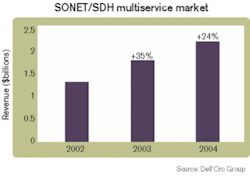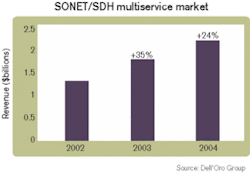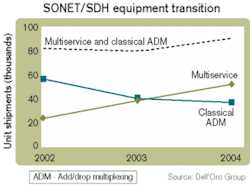SONET/SDH multiservices lifted by platform sea change
The SONET/SDH multiservice market grew 35% last year to $1.8 billion and represented 29% of the total optical transport equipment market. During this same time period, the total optical transport equipment market (including DWDM, SONET/SDH, and optical switches) declined 16% to $6.3 billion. Robust growth in the SONET/SDH multiservice market is expected to continue this year.
But before going into what that market potential is and why, let's define what a SONET/SDH multiservice product is: A common term for products in this market is multiservice provisioning platform (MSPP). However, Dell'Oro Group refers to this market as SONET/SDH multiservice to capture the increased functionality of this new product architecture without opening the segment to non-SONET/SDH systems based on technologies such as DWDM or packet switching. Following are some SONET/SDH multiservice product characteristics:
- A SONET- or SDH-based architecture rather than a DWDM- or packet-based architecture, permitting backward compatibility to the large installed base of SONET and SDH infrastructure.
- Incorporates an integrated crossconnect switch fabric, allowing a single chassis to manage data across multiple rings and increasing the platform functionality and versatility.
- Includes the latest technology and protocol support to give it a data-centric personality, enabling new service delivery.
- Designed for metro applications where the variety of interfaces and crossconnection capabilities can be exploited.
We forecast a 24% growth in sales of SONET/SDH multiservice equipment this year as the total optical transport equipment market enters a stage of recovery (see Figure 1). What is driving the strong sales of SONET/SDH multiservice equipment? The primary driver is simply the transition from an older to a newer, more cost-effective multiservice platform. As Figure 2 shows, unit-shipment growth of SONET/SDH multiservice equipment was offset by the decline in unit shipments of classical add/drop multiplexers (ADMs) last year. In general, service providers opted to purchase SONET/SDH multiservice equipment in place of classical ADMs. Factors that contribute to this product transition include:
- Price. SONET/SDH multiservice equipment has a better price-performance ratio than ADMs.
- Application. SONET/SDH multiservice equipment was designed for metro applications, which is where service providers are focusing network investments today.
- Compatibility. As a next-generation SONET/SDH product, this equipment is backward-compatible with the existing SONET/SDH infrastructure and can support the increasing demand for data services as well as traditional voice services.
- Technology. The platform's versatility permits its use as an ADM, crossconnect, or high-density aggregator. Previously, multiple platforms were required for similar capabilities.
Stated another way, the SONET/ SDH multiservice platforms enable service providers to prepare for future network needs without disrupting the existing network architecture—evolution without disruption.
In 2002, the top three vendors in SONET/SDH multiservice equipment were Alcatel, Cisco Systems, and Nortel Networks, all holding a combined 75% share of this market (see Table). No other vendor came in close to their market dominance. But as the market grew last year, a number of vendors made strong share gains.Although Alcatel, Cisco, and Nortel remained the top three vendors, their combined share dropped to 58%, as Fujitsu, Lucent Technologies, and NEC made gains.
Now the question remains: Will the SONET/SDH multiservice market continue to grow in 2005 and 2006, or will the emergence of reconfigurable optical add/drop multiplexers create a new tidal shift and a new transition?Jimmy Yu, a senior analyst at Dell'Oro Group (Redwood City, CA), covers the optical transport equipment market. He can be reached via the company's Website, www.delloro.com.




